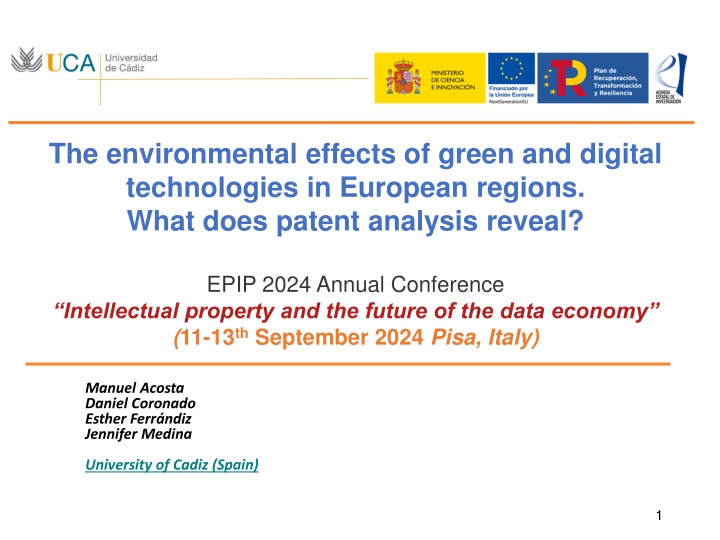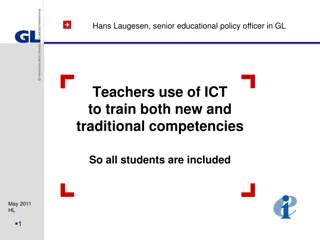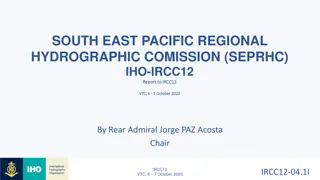
Effects of Green and Digital Technologies on CO2 Emissions in European Regions
Explore the environmental impact of green and digital technologies in European regions through patent analysis. Gain insights on the role of eco-technologies in reducing CO2 emissions and the potential effects of digital technologies on environmental sustainability. Join the discussion at EPIP 2024 Conference in Pisa, Italy.
Download Presentation

Please find below an Image/Link to download the presentation.
The content on the website is provided AS IS for your information and personal use only. It may not be sold, licensed, or shared on other websites without obtaining consent from the author. If you encounter any issues during the download, it is possible that the publisher has removed the file from their server.
You are allowed to download the files provided on this website for personal or commercial use, subject to the condition that they are used lawfully. All files are the property of their respective owners.
The content on the website is provided AS IS for your information and personal use only. It may not be sold, licensed, or shared on other websites without obtaining consent from the author.
E N D
Presentation Transcript
The environmental effects of green and digital technologies in European regions. What does patent analysis reveal? EPIP 2024 Annual Conference Intellectual property and the future of the data economy (11-13thSeptember 2024 Pisa, Italy) Manuel Acosta Daniel Coronado Esther Ferr ndiz Jennifer Medina University of Cadiz (Spain) 1
1. Introduction Motivations CO2 emissions are the primary contributor to global climate change, with 70% of which are linked to excessive energy consumption (IEA, 2017). Green technological progress is a key factor in reducing energy intensity and environmental impact (Bianchini et al., 2022; Pan et al., 2021; Naqvi 2021; Tobelmann and Wendler 2020; Wang et al. 2020; Ghisetti and Quatraro 2017). But it is unclear whether digital technologies can help to tackle the problem (Rolnick et al. 2019) or worsen environmental problems (Bianchini et al., 2022). Little evidence on the effects of the twin transition on emissions. Bianchini et al. (2022) is the only attempt, but he neglects knowledge spillovers and is not focused on energy technologies. Knowledge spillovers are a key source of technological progress (Romer, 1986; 1990), but studies linking innovation and CO2 emissions often ignore them. 2
Objective To analyse the effects specialisation in digital eco-technologies in energy domains on CO2 emissions at the regional level. of the use of eco-technological knowledge and Our contribution - We provide quantitative evidence on this topic at the regional level. - We include the effect of national and international knowledge spillovers. - We rely on an original sample of over 140k patents in the energy eco- technology domain, of which 16K are related to digital domains. 3
2. Literature review and hypotheses 2.1. Innovation, knowledge spillovers and emissions Green energy technologies - Implementing green technologies can reduce energy use and promote resource conservation and recycling, which (Chakraborty and Mazzanti, 2020, Pan et al., 2021) and, thus, CO2 emissions. will directly affect energy intensity H1: The access to internal eco-tech knowledge in the region reduces regional CO2 emissions. Digital technologies Digital technologies may help to tackle environmental problems (see, e.g., Rolnick et al. 2019). But they can increase emissions for several reasons: intensive energy consumption (Dusik et al. 2018; Jones 2018; Strubell et al. 2019); most of the materials cannot be re-cycled or re-used, leading to a technological dead end and waste management issues, hence increasing emissions (Shift Project 2019; Kunkel and Matthess 2020). - - H2: The regional specialization in digital energy eco-technologies increases regional CO2 emissions. 4
Knowledge spillovers and CO2 emissions Knowledge spillovers can expand the use of existing green technologies and improve the utilization of green technologies, thereby affecting energy efficiency (Chakraborty and Mazzanti, 2020) and thus CO2 emissions. - A region that absorbs external knowledge increases its available knowledge stock and stimulates further innovation (Pan et al., 2021), which in turn could lead to a reduction in CO2 emissions. - The effects of national or international knowledge spillovers may differ due to increased technological, cultural, geographic, and linguistic distance across countries that can hinder the absorption, and thus the effects of external knowledge. - H3: National knowledge spillovers of energy eco-technologies reduce regional CO2 emissions. H4: International knowledge spillovers of energy eco-technologies reduce regional CO2 emissions. 5
Figure 1. Theoretical model on the effect of energy eco-technologies knowledge (En-ecotech) Other factors (i.e.economic growth, economic structure, policy) Use of Internal knowledge in En-ecotech Region H1 (-) Specialisation in Digital En-ecotech H2(+) CO2 emissions H3(-) Country National knowledge spillovers of En-ecotech H4(-) International knowledge spillovers of En-ecotech 6
3. Data Patent families with at least one application to the EPO. Unit of observation: NUTS 2 regions in Europe. 5.507 observations: 197 regions of 19 countries for the period 1990-2022 (unbalance panel) . Dataset: 1) We gathered patents in energy with environmental applications (OECD, 2022). 140,666 patents. 2) From these, we identified whether they are also related to digital domains (Baruffaldi et al. 2020; Martinelli et al. 2021; Ardito et al. 2018, Bianchini, 2023). 16,937 patents (12,04% of total energy eco-patents). Steps 1&2: IPC/CPC codes and/or keywords. 3) We regionalised all patents by NUT2 in EU (or by countries if non-EU). 4) For each EU-region, we computed the internal, national, and international weighted stocks of knowledge. Perpetual inventory method. Weight: share of internal, national, or international backward citations over the total number of backward citations, respectively (Mancussi, 2008). 5) Retrieve control variables. Sources: EPO Worldwide Patent Statistical Database (PATSTAT, 2023 version). Control variables: Eurostat, ARDECO, others. 7
4. Variables and model Variable Description Source Dependent var. Co2_emissions Log CO2 per capita EDGAR & ARDECO Main independent var. (Three lags with respect to the dependent variable) l_Internal_stock_pc Stock per capita of energy eco-patents within region i (logs) PATSTAT l_National_stock_pc Stock per capita of energy eco-patents in other regions within the same country (logs) l_International_stock_pc Stock per capita of energy eco-patents in other countries (logs) Specialisation_deco (Stock of digital eco-patents within region ij/total stock of eco-patents within the region)/ (stock of digital eco-patents within country j/total stock of eco-patents within the country j) (Without weights) Control var. Growth rate of GDP per capita GDPpc_growth ARDECO GDP per capita at constant prices 2005 (logs). l_gdppc (and sqr) Industry_share Share of industry value added to regional GDP (%) World Bank Renewable Renewable energy consumption (% of total final energy consumption). Country Indicator of stringency of environmental policy with three lags. Ranges from 0 to 6 (highest). Country Multilevel specification. Level 1: region; Level 2: country OLS models (with RSE, including year, country and sectors dummies. Stringency (and sqr) OECD Models: 8
-Internal regional stock not relevant. -External stocks relevant (-): more use of external knowledge, less emissions) 5. Results MULTILEVEL MODELS Total energy. Digital ..energy 1 Coef. OLS No digital energy 3 Coef.. Digital energy 5 Coef. No digital energy 6 Coef. -Specialisation in digital eco- technologies relevant (+): More specialisation, more emissions. Total energy 4 Coef.. Dep:ln_co2_pc 2 Coef.. L3.l_internal_stock_pc L3.l_national_stock_pc L3.l_international_stock_pc-0.0656*** -0.0535*** L3.Specialisation_deco gdppcgrowth l_gdppc l_gdppc_sqr Industry_share Renewable strigencyL3 strigencyL3_sqr -0.0260 -0.1904*** -0.0965*** -0.0785 -0.0082 -0.1925*** -0.0675*** 0.0403** 0.0028 2.7431* -0.1416** 0.0363*** -0.0168* -0.6101*** 0.0909*** -0.0281 -0.1922*** -0.0966*** -0.1942*** -0.0658*** -0.0534*** -0.0677*** 0.0408*** 0.0465*** 0.0028 0.0070 2.7281** 0.1848 -0.1415** -0.0197 0.0364*** 0.0279*** -0.0184 -0.0243** -0.6297*** -0.4164** 0.0931*** 0.0569* -0.0815 -0.0095 0.0404** 0.0028 2.6782* -0.1381* 0.0363*** -0.0162* -0.6132*** -0.4036** 0.0916*** 0.0460*** 0.0070 0.1638 -0.0176 0.0279*** -0.0203** 0.0407*** 0.0029 2.7970** -0.1452** 0.0363*** -0.0191 -0.6264*** 0.0923*** -GDP growth not relevant -Per capita income: Total and no digital inverted U-shape 0.0557* _cons lns1_1_1 -18.3991***-5.9839 -18.6914*** -18.7041***-5.9056 -18.9991*** -Industry share relevant and + _cons lnsig_e _cons 0.0172 -0.0196 0.0151 0.4146*** 0.4263*** 0.4147*** -Renewable energy consumption: relevant and Obs. N groups Log likelihood 5507 19 -10139.79 5507 19 -10203.03 5507 19 -10140.24 Obs. R R_A Log likelihood -10087.83 5507 0.3777 5507 0.3630 5507 0.3776 Wald chi2(7) chi2_c 412.96*** 1634.90*** 1541.90*** 278.44*** 411.99*** 1635.43*** -10151.93 -10088.31 -Stringency : U shape 9 Std. errors not displayed for simplicity.
5. Conclusions - The use of internal energy eco-tech knowledge does not affect CO2 emissions, but external eco-tech knowledge spillovers decreases emissions (both national and international). (H1 not supported; H2,H3 supported). - The size of the effect of external spillovers is similar between digital and non digital eco-tech, although the impact is slightly lower for the former. - Specialisation in digital energy eco-technologies increase CO2 emissions (H4 supported). - GDP growth does not affect CO2 emissions (maybe because using total GDP growth instead of industrial GDP growth?) - Renewable energy consumption reduces emissions and the industry share in the regional GVA increases emissions. Expected. - Policy stringency reduces CO2 emissions, although the effect is U-shaped. 10 10
Policy implications Since the use of external knowledge (national and international) is crucial for reducing emissions, we derive two implications: 1) Increasing national and international stocks, which could demand a joint effort involving policies and instruments developed by countries and EU governments. 2) Improving accessibility to external knowledge pools. For example, by enhancing researchers mobility and collaboration. For now, the potential of the digital technologies to decrease CO2 emissions has not been unlocked and our results suggest that their environmental costs still exceed their benefits in terms of CO2 emissions. Keep fostering renewable energy consumption. Implement stringent environmental policies, but only up to a certain point. Limitations and extensions -Replace GDP growth by industrial GDP growth in our models. -Endogeneity? 11
Many thanks Funding: This research is part of the R&D project TED2021-131181B-I00 funded by MCIN/ AEI/10.13039/501100011033/ and by the Uni n Europea NextGenerationEU/PRTR . 12






















